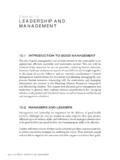Transcription of INCREASING OPPORTUNITY AND REDUCING ... - New York City
1 The New york city Commission for Economic OPPORTUNITY Report to Mayor Michael R. Bloomberg September, 2006. INCREASING . OPPORTUNITY . AND REDUCING . POVERTY IN. NEW york city . COMMISSION FOR ECONOMIC OPPORTUNITY . September 18, 2006. Dear Mayor Bloomberg, Enclosed is the report on REDUCING poverty in New york city prepared by the Commission for Economic OPPORTUNITY . In the months since you charged us with our work, we have undertaken a comprehensive examination of poverty in our city , analyzing its causes, scope and consequences. We have engaged in discussions with a broad spectrum of people from different professions and communities, including business, labor, government, academia, foundations, and neighborhood and religious organizations. We have looked closely at a full range of anti-poverty programs and paid particular attention to those that had a measurably positive impact. It is our fundamental conclusion that poverty in New york city can be reduced.
2 Exactly how large that reduction will be depends on a number of variables, including the critical role of federal and state policies outside the city 's control. Yet, if firm commitments are made, if specific goals are identified and measurements for progress spelled out, if accountability is built into the decision- making process, we are confident the reduction in poverty can be significant. It is also a basic finding of this Commission that the time to act is now. The city 's overall economy is strong. New york 's role as a global center of media, finance, and culture continues to grow. New industries are being formed. Established businesses are working hard to re-invent themselves. Perhaps most significantly, your Administration has created an environment that enables this work to occur. The premium you have placed on accountability in government, the results you have achieved in education, housing, and job development, and the willingness you show to test new strategies to overcome our most intractable problems all are essential.
3 COMMISSION FOR ECONOMIC OPPORTUNITY . REDUCING poverty will lessen the toll that deprivation takes on families and individuals. Just as important, it will add to the supply of educated, adaptable and highly employable workers so critical to building on the city 's momentum and securing its economic future. Given the time and effort already invested in reforming and redirecting our schools and the successes that have resulted . we believe this is the right moment to put in place a far-reaching strategy to enhance and extend those reforms. In framing its recommendations, the Committee kept in mind the funding limitations that exist. While we neither anticipate nor advocate massive new expenditures by New york 's public or private sector, it is clear that new strategic investments are a required part of any targeted approach to REDUCING current levels of poverty. Equally, we believe it is imperative that the large amounts already being spent be leveraged for greater impact and, where appropriate, redirected to produce the needed outcomes.
4 We have focused on rethinking and redirecting existing programs and initiatives in order to replicate programs with a demonstrable record of success, test well- designed alternatives that have the potential to make a difference, and encourage a disciplined and coordinated approach to making investments that can deliver the greatest results. In those areas where new investments make long-range economic sense, particularly at the neighborhood level, they will not be on a scale that strains the city 's finances. Any successful effort to reduce poverty must confront its complexities. Poverty has multiple causes and wears many faces. Some people require only short- term support in order to move up the economic ladder. Due to age, chronic illness, or mental or physical impediments, other cannot survive without a consistent level of help and support. The Commission has identified three groups the working poor, young adults and young children that we believe can benefit most directly, immediately and dramatically from well-focused and coordinated interventions.
5 We have not attempted to offer definitive or prescriptive proposals tied together in a single initiative. Rather, we have identified areas in which, we believe, concentrated and deliberate investment and/or intervention will produce meaningful results. The city must ultimately decide which recommendations deserve implementation as well as what legislative or administrative agendas must be followed to carry them out. COMMISSION FOR ECONOMIC OPPORTUNITY . Our recommendations, however, in no way reflect a reduction in or retreat from New york city 's historic commitment to helping those unable, whether temporarily or permanently, to care for themselves. We uphold and affirm that commitment, though we recognize it is distinct from that which we recommend here. We are grateful, Mr. Mayor, for the OPPORTUNITY to consider how best to enlarge the possibilities for economic advancement for those struggling to overcome punishing, often crippling disadvantages.
6 The issue is, unavoidably, looked at in terms of categories and statistics. But we have tried never to lose sight that behind the numbers are flesh-and-blood individuals with talents and ambitions, each part of the diverse, vital and vibrant community that makes New york the most dynamic city on earth. Our work has reinforced our appreciation for the serious dimensions of poverty in our city , state and country. The implications are large and daunting. Yet, at the same time, we have been left with a renewed sense of optimism. No community has greater reserves of ingenuity, creativity and hope. No city has a prouder history of bold aspirations and precedent-setting achievements. What is needed now is the willingness to put in place a plan of action with clear standards for measuring progress and assigning accountability, and the resolve to follow through. As well as helping thousands of New Yorkers improve the material condition of their lives, the city 's success in REDUCING poverty will serve as a reminder of our ability as a society and as a nation to achieve constructive change.
7 The ultimate impact will be felt far beyond the five boroughs. Geoffrey Canada Richard D. Parsons Co-Chairman Co-Chairman COMMISSION FOR ECONOMIC OPPORTUNITY . TABLE OF CONTENTS. INTRODUCTION .. 2. POVERTY IN CONTEXT .. 4. POVERTY IN NEW york city .. 8. THE WORK OF THE COMMISSION ..10. TARGET POPULATIONS ..12. THE WORKING POOR ..14. YOUNG ..26. YOUNG .. 36. IMPLEMENTATION .. 40. CONCLUSION ..46. INTRODUCTION. C OMMISSION FOR ECONOMIC OPPORTUNITY . INTRODUCTION. Poverty has a long history in New york . The conditions poor New Yorkers have lived under have often been extreme, and the deprivation they have endured has had consequences for the entire city . Yet, it is important to remember that what draws the poor to New york has always been the hope that here, more than any place else, they can build a better life for themselves and their children. This has been true for countless generations, no matter their religion or race, or whether they arrived from Europe, Asia, Africa, the Americas or parts of our own nation.
8 " .. The desire Equally, while it is true that poverty has presented challenges for our city , poor and determination New Yorkers also embody immense resources of ingenuity, imagination, and of New york 's intellect. Over and over again, the desire and determination of New york 's poor poor to achieve to achieve their share of the American Dream has been a source of the energy their share of the and ambition that defines our city . American Dream has been a The fundamental purpose of our Commission has been to pinpoint concrete ways source of the energy and in which our city can act to ensure poor New Yorkers have the resources they ambition that need to help themselves move ahead. Obviously, the federal and state defines our city ." governments have critical and vital roles to play, and their involvement and support are indispensable. So, too, there are areas in which the immense talents and strengths of New york 's private sector must be brought into play.
9 But to recognize the limits city government faces in combating poverty is not to resign ourselves to inaction. On the contrary, we are convinced that by focusing on target populations, building on successful precedents and ongoing initiatives, and implementing new and innovative approaches, we can help foster a new confidence in our ability to reduce poverty in a systematic and permanent fashion. In undertaking its work, the Commission began by recognizing that poor New Yorkers aren't a single undifferentiated mass, uniform in circumstance, experience, capacity or hope. The poor in New york and throughout the nation vary in many ways. There are no one-size-fits-all solutions. Strategies intended permanently and significantly to reduce their numbers must be flexible and nuanced. Analysis of the data led the Commission to conclude that there is great value in focusing renewed attention and targeted resources on the segments of the community positioned to move out of poverty, and we recognize that care must continue for New Yorkers unable to care for themselves.
10 Caring for the least able among us is a proud tradition in New york a legacy of generations whose struggle is reflected in our public institutions and social policies and must be made as fair, efficient and humane as possible. 2. COMMISSION FOR ECONOMIC OPPORTUNITY . We know from past and recent history that poverty isn't an intractable problem. Along with the wealth-creating prowess of the free market and the poverty- REDUCING effects of economic boom times, we've seen government programs in education, housing, nutrition, and small business developments that have helped improve the material condition of many in need. The Commission has concentrated its attention not on the speculative but on strategies that have a proven record of results. Our intent is to bring together New york 's public and private resources in coordinated and concentrated efforts that build on successful precedents and have a measurable impact.













